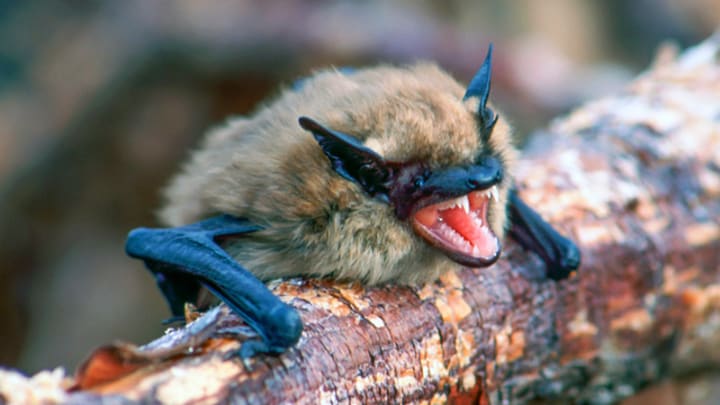It’s hard to understate the threat of white nose syndrome to North American bats. Since its arrival on the continent sometime in the early aughts, the fungal disease has reduced the populations of three species by 90 percent—it can quickly wipe out entire colonies and has killed about 6 million of the winged mammals. One prominent researcher called it “the gravest threat to bats [we] have ever seen.”
But now, after 20 years of warnings and despair, chiropterists and wildlife managers have developed a few proactive tools to combat the disease and reduce the death rate. If these measures—recently detailed in The New York Times—continue to be successful, they could herald the beginning of the end of the bat pandemic.
White nose syndrome is caused by a particular fungus that arrived from Europe, where bats had developed immunity to it. When a bat carries it to a hibernaculum—a secluded spot, like a cave, where bats hibernate during the winter—the fungal spores spread and linger. The resulting infection disturbs bats’ rest, forcing them to waste energy from the fat reserves they stored before hibernating. This hacking of their metabolism can cause bats to become malnourished and even starve to death.
In 2013, researchers tested a chemical called polyethylene glycol 8000 (PEG) on the fungus that causes white nose syndrome. The chemical is used to control fungal infections in agriculture and has several sanitizing functions in human medicine. In these tests, the PEG coated the fungus spores and stopped them from growing.
In 2018 and 2019, before the hibernation season, a team led by the Pennsylvania Game Commission sprayed an abandoned train tunnel used as a hibernaculum with PEG. They later found diminished infection rates.

These researchers also noted that bats who hibernated in colder parts of hibernacula increased their odds of survival, perhaps because these areas reduced their thirst and thus their need to fly around seeking water, which uses up the stored energy bats need to withstand the effects white nose syndrome.
The Pennsylvania team began funneling cool air into hibernacula and warm air out. In Woodward Cave in Centre County, near State College, they even created artificial hibernacula with cool air, plentiful water, and a coating of PEG.
Another group of researchers, this one with Bat Conservation International, has had some success with another, simpler tactic. In Southern Illinois, they put out food for bats in summer, beefing them up to survive white nose syndrome during the winter.
Some people may erroneously believe bats are icky or creepy. Until a certain DC Comics creation from 1939, the folklore and misconceptions around them were not flattering. Yet bats are critical to ecosystems: they pollinate plants and even give us tequila, disperse seeds to regrow forests, and eat bugs that would otherwise harm crops, saving farmers as much as $53 billion a year in pest control.
Read More Fascinating Facts About Animals:
